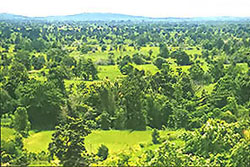| 1. The MAPNET Project We have been engaged in a research project, called Modeling Agricultural Productivity in Northeast Thailand (MAPNET). Many of the global environmental problems we now face are closely connected to agricultural activities undertaken to feed the Earth’s vast human population. The destruction of rainforests and the loss of biodiversity can be largely traced to the expansion of agricultural lands, including shifting cultivation. Desertification and the salinization of soil represent a loss of soil productivity caused by over-cultivation and over-grazing. Therefore, ensuring the sustainability of agriculture will almost automatically lead to the preservation of the global environment. In order to ensure this sustainability, it is imperative to understand the limits on the productivity of farmland, and manage that land accordingly. In other words, the evaluation of soil productivity is an essential prerequisite to ensure the sustainability of agriculture. The purpose of the MAPNET project is to develop a method to evaluate potential land productivity on the basis of the idea and approach described above.
KONO Yasuyuki |
 Landscape in Northeast Thailand. The Northeast makes up one third of the country in both area and population. The undulating plateau, 150 to 200 meters above sea level, stretch out, with rice grown in lowland paddy fields, relying solely on rainwater. Cassava and sugarcane are cultivated in higher areas. The agricultural production is very unstable, under the effects of year-to-year changes in precipitation.
Landscape in Northeast Thailand. The Northeast makes up one third of the country in both area and population. The undulating plateau, 150 to 200 meters above sea level, stretch out, with rice grown in lowland paddy fields, relying solely on rainwater. Cassava and sugarcane are cultivated in higher areas. The agricultural production is very unstable, under the effects of year-to-year changes in precipitation.